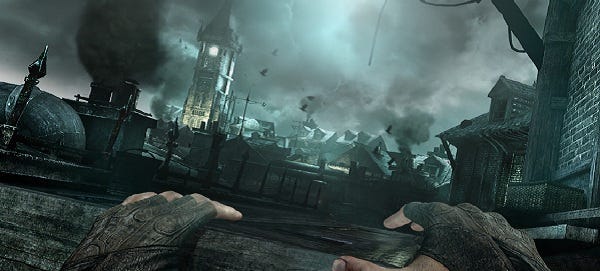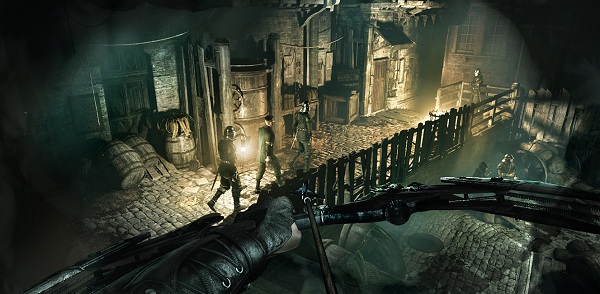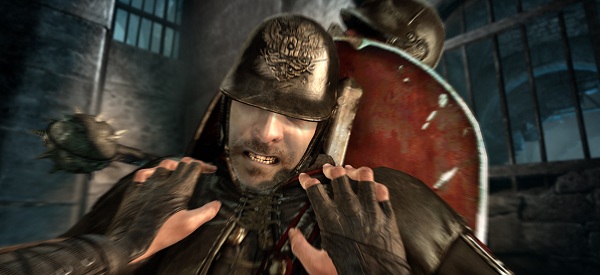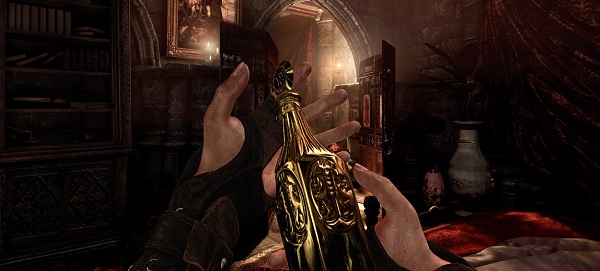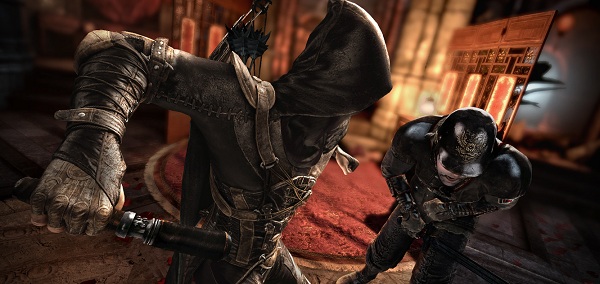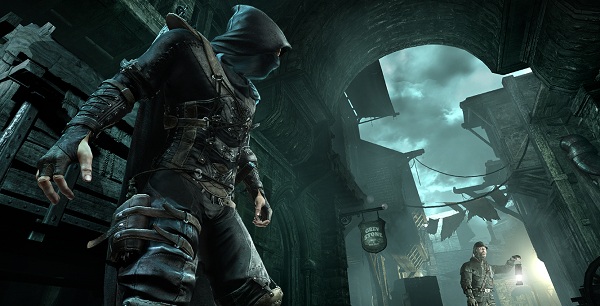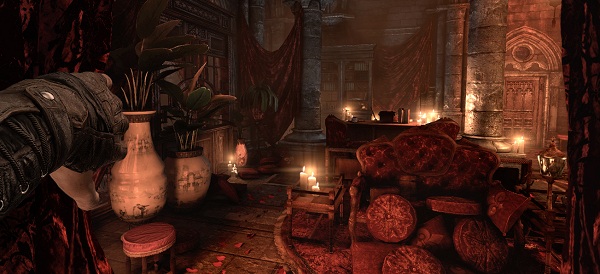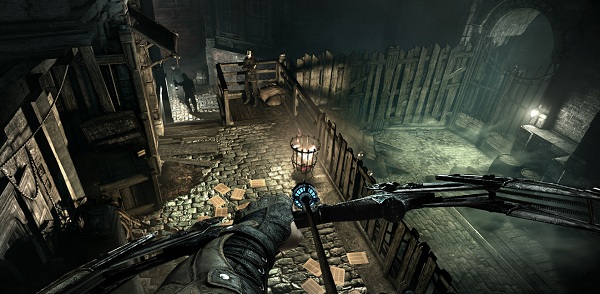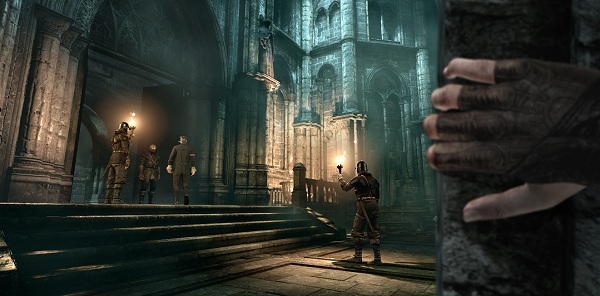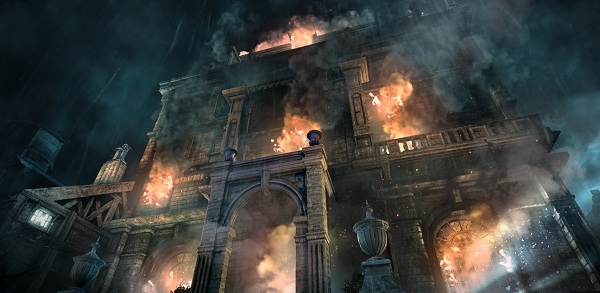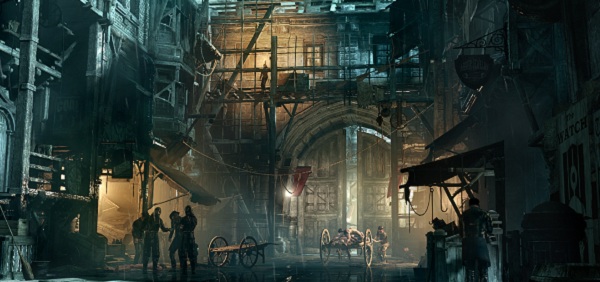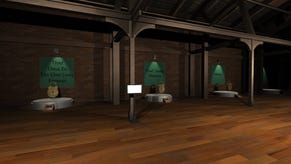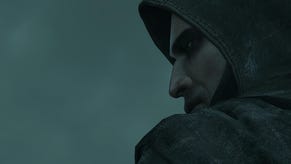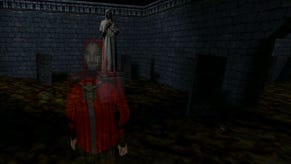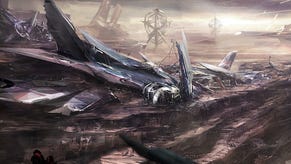First Look: Thief
Inside At Last
I spent a huge portion of my teenage years either playing Thief or thinking about Thief, and I've never really stopped. A couple of weeks ago, armed with a questioning mind, I travelled across an ocean to see Thief: No Longer Four and to talk to the development team at Eidos Montreal. The '4' is gone because crimes against typography and sense can only be endured for so long, and also because this is a reboot rather than a sequel. With my archaeological hat sitting atop my sceptic's cap, I was determined to find whatever traces of the old remained and to see what remains for those who remember the original series so fondly.
It's impossible to know, following this first proper reveal and without having played any of the game myself, whether the impressive technology that is one of the cornerstones of Thief’s new incarnation will amount to anything more than a superior spectacle but. What is clear, following an hour long in-game demonstration and a controlled tech demo of the excessively detailed fire, smoke and weather mechanics, is that Eidos Montreal are building an edifice with every modern convenience, some of which may be welcome and others which may sit uncomfortably with the expectations of those who lived through the Metal Age.
Garrett was born in adversity, the antihero of a game that would have been style over substance if it hadn't been so packed full of substance, or substance lacking style if it hadn't been the most stylised fantasy/steam-punk hybrid in existence. Thief's world was never one thing or the other - it was its own thing, a borrowing from history, literature and the wider world of fiction that embodied ideas of class warfare, industrialisation, religious fractions and gothic masque all at once. There has been nothing quite like it in gaming since and Thief's greatest crime could be that it does not 'borrow' enough from its predecessors, instead building something that is attempting to be both murky and brilliant, and also somewhat new.
Before discussing what Thief may or may not be, it’s important to remember what it was. Many of the apparent changes that are already drawing ire and, indeed, in some cases made me frown on the day, can stand to be re-examined in the context of reality rather than memory. Garrett isn't as amused and distant from troubles, here more grim and dangerous from the very opening of the game, which sees him returning to The City after an inexplicable and mysterious absence. However, replaying the original game proves the apple to be wind-fallen rather than storm-tossed, and not quite as far from the tree as may be imagined.
The City has changed. Garrett has changed. And yet, more convincing than the demonstration itself, which showed one of the most ambitious meetings of advanced technology and art design that gaming has produced to date, the people in control of the game's narrative and thematic destiny are aware of something fundamental: the relationship between the master thief and his City is the centre of everything. There are thousands of lines of speech in the game, all recorded in a purpose-built studio, and while it’s disappointing to hear that the peculiar linguistic traits of The City have become a thing of the past, it’s reassuring that Garrett will, as ever, be talking to himself. Or, as it was put to us, ‘talking to The City, which is the game’s other lead character’. Even if I may not like some of the new voicework, that statement is music to my ears.
To be clear, the voice acting is well-executed, it just seems a terrible shame that the slang and accents that ran through The City as strongly as mortar and water are perhaps being dismissed as something allusive and on the level of footnote or in-joke. The language of Thief was as much a part of the atmosphere of the place, its credibility and otherworldiness, as the skyline or the shadow. To hear guards swear is not only crude in a linguistic sense, I find it confounding and it causes the sense of place, so immaculately crafted, to creak at the seams.
The fears of other changes, of quick time events and hyper-action sequences, are unwarranted. The Focus ability may cause purists to squirm (I am one and I did) but apart from a solitary user-triggered slow-motion combat sequence, very much a last resort and part of an escape rather than an assault, Focus was used for thievery rather than violence. Plucking the rings from somebody’s ears is preposterously silly but it’s an act of outrageous daring and deftness that leaves a grin on the face. Garrett is good at this, the game tells you, a master thief, and limited use of Focus throughout a mission allows him to demonstrate the peak of his abilities. From what has been shown to the press in this demonstration, it's clear that Garrett is a thief who will spend his time thieving, and while the plot will no doubt send him on a cataclysmic course that requires adaptation and adjustment, that’s nothing new.
Take The Dark Project: the gap between infiltrating a believable faux-medieval manor and dodging the festering belch-gas of giant bipedal oaf-beasts in a series of zombie-infested catacombs was one level, and that was a prison break-in that took a detour through a haunted mine. The level design in The Metal Age had more focus, more thievery and possibilities for avoidance of conflict, and while Eidos Montreal are rebooting and revamping the series, it’s the second game’s setting that new Thief most resembled during this first look.
The scant details of the plot that have been revealed suggest that the narrative will throw Garrett on a collision course with an industrialist Baron who has taken political control of The City, using The Watch, his personal army of thugs. There’s also a plague, which combined with the decadent brothel of the demonstration level to draw an uncomfortable proportion of Dishonored parallels. Despite his increased agility and eyeshadow, Garrett is still very much a thief rather than an assassin or goth-model, and while he’s capable of pulling off the occasional slow-motion murder, fighting is a last resort. Even if he is capable of slaughtering every guard in a level – and the bodies piled high during my last visit to Lord Bafford’s cellars would argue that his previous incarnation could do the same – it’s an approach fraught with peril and likely to detract from his ability to excel in the task at hand; robbing everything that isn’t nailed down.
Apart from death, Thief avoids fail states. Escape, or the discovery of an alternate route, will always be an option. The level we were shown begins in the streets of The City with Garrett stalking his prey, a nobleman with a tempting trinket who is heading for a location across the rooftops and far away. Clambering onto a rooftop, overhearing talk of violent crack-downs and a populace on the verge of revolt or collapse, the player sees the urban sprawl stretching before them. The view is astonishing, for its scale, detail and design. The City will be an open playground, with side missions to discover and loot to gather, and if this early glimpse is more than smoke and mirrors, a view that the freedom exhibited in the playthrough strongly supports, its creation will be a landmark achievement.
Black cords of ash and soot hang in the air like an oppressive net over the Victorian skyline and, later, flashes of lightning send white light dancing across individual raindrops and puddles, casting crazy shadows across the cobbles. Fog shifts like a living thing and all of it combines to make contrasting shapes of varied darkness and light that act as an ever-shifting patchwork obstacle course for Garrett, who can use any pool of darkness or obscurity as a vanishing point. Many of the technological tricks are striving for the same impact on design as the Dark Engine’s light sources did so many years ago, with the main difference being that we are apparently living in the distant future now. Everything that was shown was running on PC rather than one of the nextest generation consoles on which the game will also be released, and the effect was like seeing a bike soar down a street with its stabilisers removed.
And yet, even as Garrett scrambled across rooftops, traversing City blocks at an incredible rate, ducking through open windows and over alleyways, I was simultaneously filled with wonderment and tensed with uncertainty. It’s a beautiful, extraordinary place, this city, but is it recognisable as a version of The City? The weirdness, that not-quite steampunk ahistorical off-kilter sensibility, was lacking.
The rooftop pursuit is a race against time. A clock is striking twelve, the sound thundering across the district, and Garrett must reach the red light before the chimes end and the door to the brothel is locked for the night. Good grief, I thought, do I really want a time limit in my Thief game? Do I really want to sneak around another brothel?
The latter question is still on the table but the time limit can be dismissed. Fail to reach the door in time and the mission won’t begin again – this isn’t about finding the perfect free-running line - but the easiest entrypoint will be closed. Maybe you’ll have to find an entrance somewhere deeper, in the City’s underbelly where it keeps its underclass, or perhaps, with a little ingenuity, it’ll be possible to unlock the gate. Until we actually play the game, it’s impossible to know how satisfying these freedoms will be but the promise of them is a salve for those who fear a more linear experience.
As for The City’s weirdness, it becomes more apparent. It’s perhaps too generous to see the surface level, that Victorian London topping, as an intentional cork on top of the more uncomfortable underground, but it’s clear that the design takes ‘verticality’ as a central tenet. Garrett spends more time climbing than he has previously, which leads to the already-maligned third-person viewpoint when he attaches to a wall. It was rarely used in the demonstration and explained away with a slightly apologetic shrug, ‘in first-person, you’d only be able to see the wall right in front of you’. Scroll through this page and notice Garrett's hands in the first-person view screenshots. When he isn't wielding a weapon or examining loot, the hands interact with the environment, gripping corners as he leans, brushing against walls and tables as he passes. It's an effective spatial tool and helps make his body, which physically exists rather than being a floating camera, an active part of the environment.
Returning to climbing and dangling from ropes, it's clear that the use of height, scale and scaling isn’t only a facet of level design, it’s a facet of urban design. While the surface of The City is gaslights and plush, over-ripe luxury, bursting with corruption and abuse, just beneath lie the furnaces and workshops. Steam, chains and metal, dangerous, dirty and darker. That’s not all though; like a three-tiered cake, the City has a broad base and it’s here that it most resembles its former self. The Victorian brothel has an opium factory tacked on its side, all clanky metal gratings and over-anxious workers, and below that, at its very foundations, it’s something else entirely, a huge edifice of medieval design, part castle, part sanctuary. The walls are solid – this place will endure longer than the ephemeral everyday above – and they carry markers, the symbol of the Keepers, an easily missed but thrilling reminder of The City’s past, the series’ past and Garrett’s past.
Short of stealing the design documents, I tried my damnedest to find out more about the existence of factions from the previous games but nobody is ready to talk yet. I did have a debate with the lead level designer as to whether The Metal Age is the best game in the series (having replayed both games since, I admit now that I was wrong to back The Dark Project – nostalgia, eh?) and uncovered a studied, cerebral and critical knowledge of the Looking Glass titles that left more of a positive impression than all of the fancy lighting tech in the world ever could.
There were moments in the playthrough that looked scripted, particularly a guard following the noise of a breaking bottle and ended up on the wrong side of a barred gate, which handily closes when an arrow is fired at the switch by its side, but the team are honest about the state of the playthrough. This is not a level as it will be played, it is a compact version of the experience, condensed so as to contain infiltration, thievery and escape, a showcase of possibilities. The architectural possibilities are explicit and exciting, the storytelling is scratched into the masonry and in the overheard gossip and barked orders.
Dishonored approached stealth and urban navigation as kinetic problems, solved most often through motion rather than stasis and seclusion. Garrett’s newfound agility and his collapsible bow (I held a forged and machined replica, and almost neutered myself when I clicked the catch that opens it) will make him a less subtle knife in the dark at times, but they will also open up new pathways, above and across buildings and rooms. It’s the increased mobility of Garrett that most exemplifies the difference between then and now, but it’s the other central character, The City, that could benefit from Garrett’s ability to better traverse its greatest heights and its most wretched depths.
The trailers may emphasise crazed leaps from ramparts, gadgetry, violence and a poised, mannered edginess – a word that was used during the demonstration and that never fails to make me cringe – but even in a demo level that is constructed to be a greatest hits compilation, Garrett spent most of his time crouching in the shadows, waiting, watching and sneaking between his unwitting marks. The technology and the design are built around shadows and fog, architecture and agency, and even though Thief may, to my regret, lack some of its original voice and soul, the excavation hasn’t left those spaces empty. From the vantage of a concerned critic and interested observer, the new elements locking into place appear to have an intelligence and fascination of their own.
If the world-building is consistent and strong, and the game holds true to its intent, which is to present interesting, complex spaces and allow the player to explore them with all of the old tools of the trade, then Thief will undoubtedly delight me, despite any misgivings I maintain about some of the changes in tone. But that 'if' is very important. It's possible to play a game for an hour or two and to seize, or be offered, the wrong end of various sticks, and while I feel much more optimistic about this reboot than I did before seeing it in action, that's all that has happened. I've seen it in action, with members of the development team playing it in a controlled environment. They know that I've missed firing water arrows at torches and clubbing guards on the noggin. I've missed creeping on carpets and shuddering at the sight of a hard, stone floor. I've missed being encouraged to think about a location as a challenge and a possibility, and I reckon Thief just might bring all of those things back to me.
Oh, and I've also missed rope arrows and they're finally coming back as well.
Thief isn't coming out until 2014, which is annoying. However, in the much less distant future I'll share more details about the demonstration level and an interview with the lead level designer and producer of the game, where we discuss balancing the old and the new, whether we'll be returning to any cathedrals or cradles, and if there is even a single taffer left in The City.
